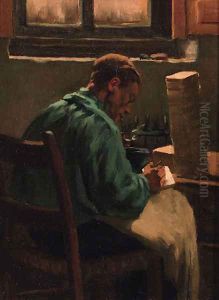Anthon Gerhard Alexander Van Rappard Paintings
Anthon Gerhard Alexander van Rappard was a Dutch painter and draughtsman, born on May 14, 1858, in Zeist, Netherlands. He is often remembered for his role as a friend and mentor to the more widely known Vincent van Gogh during the formative periods of Van Gogh's career. Van Rappard's own work, however, shows a talented artist who was deeply engaged with the social realist movements of his time and the depiction of the working class.
Van Rappard's artistic education included time at the Royal Academy of Fine Arts in Brussels, where he enrolled in 1876, and later at the Académie Julian in Paris. His style was influenced by the Dutch tradition of genre painting and the French Realists and Naturalists. Known for his realistic depictions of the everyday life of the poor, his works often focused on the lives of workers, peasants, and weavers. He had a particular interest in depicting the textile industry, which was prevalent in the area where he worked, in the eastern part of the Netherlands.
Throughout his short life, Van Rappard maintained a correspondence with Van Gogh, which has been preserved and provides significant insights into the artistic development, ideas, and struggles of Van Gogh. Van Rappard's influence on Van Gogh can be seen in the latter's early works, which also reflect a strong social realist ethos. Unfortunately, Van Rappard's relationship with Van Gogh soured over a disagreement about the quality of popular prints that Van Gogh admired but Van Rappard criticized.
Anthon van Rappard's health was poor, and he suffered from tuberculosis. His productivity as an artist was affected by his illness, but he continued to work and develop his artistic style throughout his life. Van Rappard died on March 21, 1892, at the age of 33, leaving behind a body of work that, while not as vast or renowned as that of his friend Van Gogh, contributes to the understanding of Dutch art in the late 19th century. Today, Van Rappard's works are held in various Dutch museums, and his correspondence with Van Gogh remains a valuable resource for historians and enthusiasts of post-impressionist art.
